Bonnie J. Dunbar
Bonnie J. Dunbar | |
|---|---|
NASA astronaut | |
Time in space | 50d 8h 24m |
| Selection | NASA Group 9 (1980) |
| Missions | STS-61-A STS-32 STS-50 STS-71 STS-89 |
Mission insignia | |
| Scientific career | |
| Fields | Aerospace engineering |
| Institutions | |
ProQuest 303164294 (1983) | |
Bonnie Jeanne Dunbar (born March 3, 1949) is an American engineer and retired
A graduate of the
Dunbar left NASA to become the president and chief executive officer of the Museum of Flight in Seattle, where she was involved in science, technology, engineering, and mathematics (STEM) education for high school students. From 2013 to 2015, she led the University of Houston's STEM Center and was a faculty member in the Cullen College of Engineering. She became the John and Bea Slattery professor of aerospace engineering at Texas A&M University in 2016, and was the Director of the Institute for Engineering Education and Innovation (IEEI) there from 2016 to 2020.
Early life and education
Bonnie Jeanne Dunbar was born in
Dunbar attended Outlook Elementary, a small rural school that went to the
After Dunbar graduated from high school in 1967,
As a student at the University of Washington, Dunbar took heavy course loads, but also served on the Engineering Student Council and played on its baseball team.
Engineering jobs were hard to find in 1971, so Dunbar accepted a position as an office manager at a
In 1975, Dunbar was invited to participate in research at the
NASA career
Flight controller / payload officer
NASA issued a call for applications for pilot and
Dunbar noted that all the women accepted in
Astronaut

On August 1, 1979, NASA announced another round of selections for
After completing a year of astronaut candidate training, Dunbar officially became a fully-fledged NASA astronaut on August 21, 1981.[15] Her technical assignments included assisting with the testing of the Space Shuttle onboard software at the Shuttle Avionics Integration Laboratory (SAIL). She was a member of the Flight Crew Equipment Control Board, and as such was involved in the remote manipulator system (RMS) development. She later became the chief of the Mission Development Branch, and was the Astronaut Office interface for "secondary" payloads, and the lead for the Science Support Group.[8] She was a member of the support crews for the STS-2 and STS-9 missions,[16] and worked with Walter Cronkite on the CBS television coverage of the STS-2 mission.[4]
STS-61-A
On February 14, 1984, NASA announced that Dunbar had been selected as a member of the crew for the upcoming Spacelab D-1 mission.
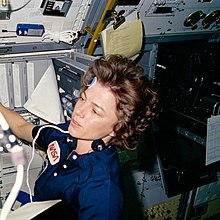
The Germans were concerned by the assignment of a woman to the mission. Some of the experiments involved drawing blood, and the possibility of female blood had not been considered, and some of the experiments like the vestibular system sled did not fit her. There were rumors that NASA had deliberately assigned her to the mission as an insult to the Germans. Dunbar reported this to George Abbey, who drafted a memo to the DFVLR stating that all equipment for the mission had to accommodate a range of sizes.[4]
STS-61-A lifted off from the Kennedy Space Center (KSC) in the Space Shuttle Challenger on October 30, 1985.[19] With eight crew members, this mission was the largest to fly in space, and it was the only mission that launched with eight crew members. For the first time, payload activities were controlled from outside the United States.[8][20] The crew of five astronauts and three payload specialists worked in two twelve-hours shifts, red and blue;[21] Dunbar was in charge of the blue shift and Bluford of the red shift.[20] Some 75 scientific experiments were carried out, ranging from physiology and biology to materials science and navigation. Although she performed various experiments, Dunbar was primarily responsible for the operation of the Spacelab and its subsystems.[8]
Challenger landed at Edwards Air Force Base in California on November 6, after 7 days, 44 minutes and 51 seconds, during which it had traveled 2.5 million miles and orbited the Earth 111 times.[19]
STS-32
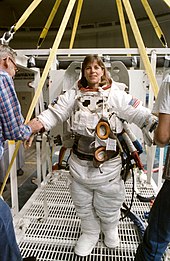
Flight assignments were canceled in the wake of the Space Shuttle Challenger disaster in January 1986, but Dunbar became the chairman of NASA's Microgravity Materials Science Assessment Task Force, which examined proposals for materials science experiments with Spacelab and the proposed Space Station Freedom. She also became a member of the Astronaut Science Support Group, that collaborated with engineers on the design of experiments and experimental apparatus.[20] On June 29, 1989, NASA announced Dunbar's assignment to her second space flight, the STS-32 mission, also known as Long Duration Exposure Facility (LDEF) retrieval mission.[22]
One of the largest payloads ever deployed by the Space Shuttle, the LDEF was a 21,500-litre (4,700 imp gal; 5,700 US gal) satellite containing 57 experiments to study the effects of long-term exposure to the
The STS-32 mission lifted off from the KSC in the Space Shuttle Columbia on January 9, 1990.[24] The crew deployed the Syncom IV-F5 satellite, and Dunbar operated the RMS to retrieve the LDEF.[20] The crew operated a variety of experiments, but Dunbar was the principal investigator of the Microgravity Disturbance Experiment using the Fluids Experiment Apparatus. Other experiments investigated protein crystal growth, echocardiography, latitude/longitude locating, mesoscale convective system lightning and circadian rhythms. The crew themselves were test subjects for investigations of the benefits of in-flight aerobic exercise and human adaptation to extended duration missions. Activities were filmed using an IMAX camera.[8][24]
Columbia landed at Edwards Air Force Base after a mission lasting 10 days, 21 hours, 1 minute and 38 seconds, during which it had traveled 4.5 million miles (7.2 million kilometres) in 173 orbits of the Earth.[24]
STS-50
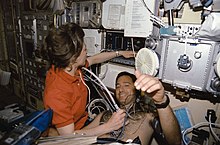
Planned Spacelab missions for the early 1990s included another mission for Germany (
The STS-50 mission lifted off from KSC in Columbia on June 25, 1992.[26] Over thirty experiments sponsored by more than researchers were housed in the Spacelab. Over the next thirteen days, the payload crew of four performed a series of experiments related to human physiology and the growth of various crystals in microgravity.[8] A microscope was carried on board so images could be taken of crystals as they were growing.[25]
Columbia landed back at the KSC on July 9, after 13 days, 19 hours, 30 minutes and 4 seconds, having traveled 5.7 million miles (9.2 million kilometres) and made 221 orbits of the Earth.[26]
STS-71
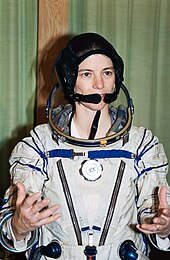
In 1993, Dunbar became the Deputy Associate Administrator in the Office of Life and Microgravity Sciences at NASA Headquarters in Washington, D.C.[8] In this role she was involved in key decisions regarding the redesign of the Freedom space station, such as the decision to use air at 14.7 pounds per square inch (101 kPa), which was necessary for experiments with plants.[25]
Dunbar returned to the Astronaut Office in Houston in December 1993. She was approached by David Leestma, a fellow member of the 1980 group of astronauts who was now the Director of Flight Crew Operations, who informed her that he needed someone to go to Russia as a backup for Norman Thagard, who had been designated to become the first US astronaut to fly in space on the Russian Mir space station.[25] Finding a volunteer for a grueling year-long training program without any assurance of a flight at the end of it had been difficult. No American astronaut had served as a backup since the early days of the Space Shuttle program, and none had flown or even trained for a long-duration mission since Skylab, almost twenty years before.[27]
Dunbar protested that while she had begun learning Russian, her knowledge of the language was far short of the fluency that would be required. After meetings with Carolyn Huntoon and George Abbey, who figured that since she had learned some German for the D-1 misison, she should be able to pick up Russian. Dunbar reluctantly agreed.[25][28] On February 4, 1994, NASA announced that Thagard and Dunbar had been selected for the prime an backup crews for a three-month flight on Mir in 1995.[29]
In February 1994, Dunbar traveled to Star City, Russia, where she spent thirteen months in training to be a back-up Mir crew member.[8] She found Russian attitudes towards women disconcerting and dismissive,[27] but made friends with Russian women who worked there as engineers and mathematicians and were eager to see her succeed.[25] This included survival training for the contingency of a landing in the Arctic region of northern Russia, which Dunbar enjoyed, as it reminded her of home. As it happened all seven Shuttle-Mir astronauts ultimately returned to Earth on Space Shuttle missions, but an emergency evacuation in a Soyuz spacecraft was always a possibility.[30] In March 1995, the Yuri Gagarin Cosmonaut Training Center certified her as qualified for long-duration Mir flights.[8] To obtain this credential she took a series of final oral examinations for each system, in which members of the training department fired questions at her in Russian.[31]

Although Dunbar did not fly a long-duration mission on Mir due to delays in negotiations, the training was not wasted, for she visited on the STS-71 mission. Dunbar was mission specialist 3 on this flight, assisting Ellen S. Baker, the payload commander.[32] The mission lifted off from KSC in the Space Shuttle Atlantis on June 27, 1995. On this mission, the Space Shuttle mission docked with Mir for the first time, and there was an exchange of crews. A Spacelab module was also carried so the crew could perform medical evaluations of the Mir crew. These evaluations were designed to ascertain and measure the effect of prolonged weightlessness on the bones, muscles, and the cardiovascular, immune system, and cardiopulmonary systems.[8]
The STS-71 mission lasted 9 days, 19 hours, 23 minutes and 8 seconds. Atlantis landed at KSC on July 7, having traveled 4.1 million miles (6.6 million kilometres) and orbited the Earth 153 times.[33]
STS-89
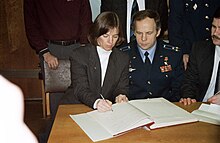
In January 1998, Dunbar returned to Mir on the STS-89 mission in the Space Shuttle Endeavour. Launched from KSC on January 22, 1998, this was the eighth mission in which the Space Shuttle docked with the Mir space station. The Space Shuttle crew transferred more than 9,000 pounds (4,100 kg) of scientific and logistical equipment, and supplies of food and water from the Space Shuttle Endeavour to Mir. For the fifth and final time, an astronaut, in this case Andy Thomas, was delivered to Mir and one was returned, in this case David Wolf. As the payload commander, Dunbar was responsible for the twenty-three scientific and technological experiments. Endeavour touched down at KSC after 8 days, 19 hours and 47 seconds during which Endeavour had traveled 3.6 million miles (5.8 million kilometres) in 138 orbits of the Earth.[8][34]
Between October 1995 and November 1996, Dunbar worked in the Mission Operations Directorate at JSC as the assistant director for ISS readiness and Russian-American cooperation.[35] In this role she chaired International Space Station (ISS) training readiness reviews, and facilitated Russian-American operational and training activities.[8]
Dunbar retired from NASA on September 30, 2005.
Post-NASA career
Dunbar left NASA to become the president and chief executive officer of the
From 2013 to 2015, Dunbar led the
Personal life
Dunbar married
Organizations
- Board of Directors, Arnold Air Society and Angel Flight / Silver Wings[49]
- American Association for the Advancement of Science[49]
- American Ceramic Society (ACerS)[8]
- American Institute of Aeronautics and Astronautics (AIAA), Fellow (2006)[8][50]
- American Society of Mechanical Engineers (ASME)[51]
- Association of Space Explorers (ASE)[8]
- Biomedical Engineering Society (BMES)[49]
- Experimental Aircraft Association (EAA)[49]
- International Academy of Astronautics (IAF)[8]
- Kappa Delta sorority[6]
- Keramos[3]
- Materials Research Society (MRS)[8]
- National Academy of Engineering, Member (2002)[52]
- National Institute of Ceramic Engineers (NICE)[8]
- Member, National Science Foundation (NSF) Engineering Advisory Board, 1993– [49]
- Royal Aeronautical Society, fellow (2008)[53]
- Royal Society of Edinburgh, corresponding Fellow (2001)[53]
- Society of Women Engineers (SWE)[3]
- Tau Beta Pi[8]
- Texas Academy of Medicine, Engineering, Science and Technology (2004)[53]
- Washington State Academy of Science (2006)[53]
Awards and honors

- Sigma Xi John P. McGovern Science & Society Award (2020)[54]
- George R. Stibitz Computer and Communications Award (2018)[55]
- Edward O. Wilson Biodiversity Technology Pioneer Award(2018)[53]
- BioHouston Women of Science Award (2015)[56]
- Elected to Astronaut Hall of Fame (2013)[57]
- University of Washington College of Engineering Diamond Service Award (2012)[53]
- American Association of Engineering Societies (AAES) Norm Augustine Award for Outstanding Achievement in Engineering Communications (2011)[53]
- ASME Ralph Coats Roe Medal (2010)[53]
- Elected to Living Legends of Aviation, California (2009)[53]
- Washington State Medal of Merit (Governor's Award) (2007)[53]
- Society of Women Engineers (SWE) National Achievement Award (2006)[53]
- ACerS Annual Meeting in Baltimore - Orton Lecture awardee (2005)[53]
- Arthur Friedberg Award, National Institute of Ceramic Engineers (NICE) Ceramic Engineering (2005)[53]
- The American Ceramic Society (ACerS) James I. Mueller Award, Cocoa Beach, Florida (2000)[53]
- Inducted into the Hall of Fame (2000), one of five women in the world so honored annually[51]
- Selected as one of the top 20 women in technology in Houston, Texas (2000)[49]
- NASA Space Flight Medals (1985, 1990, 1992, 1995 and 1998)[49][58]
- NASA Superior Accomplishment Award (1997)[49]
- NASA Exceptional Achievement Medal (1994)[49][58]
- NASA Distinguished Service Medal (1996 and 1999)[58]
- NASA Outstanding Leadership Medal (1993)[49]
- NASA Exceptional Service Medal (1988)[49][58]
- Design News Engineering Achievement Award (1993)[49]
- IEEE Judith A. Resnik Award (1993)[59]
- Society of Women Engineers Resnik Challenger Medal (1993)[49]
- Museum of Flight Pathfinder Award (1992)[53]
- AAES National Engineering Award (1992)[49]
- University of Houston Cullen College of Engineering Distinguished Engineering Alumna Award (1991)[53]
- M.R.S. President's Award (1990)[49]
- The American Ceramic Society (ACerS) Schwaltzwalder P.A.C.E. Award (1990)[49]
- University of Washington Engineering Alumni Achievement (1989)[49]
- The American Ceramic Society (ACerS) Life Membership (1986)[49]
- General Jimmy Doolittle Fellow of the Aerospace Education Foundation (1986)[49]
- Evergreen Safety Council Public Service in Space Award (1986)[49]
- The American Ceramic Society (ACerS) Greaves-Walker Award (1985)[49]
- Rockwell International Engineer of the Year (1978)[49]
- Honorary Doctor of Laws from Clemson University (1990); Honorary Doctor of Science from Clarkson University (1993); Honorary of Engineering from Alfred University (1991), Michigan Technological University (1992), Heriot-Watt University (2000), University of Glasgow (2002), University of Dundee (2002), University of Strathclyde (2014) and Rowan University (2015); and an Honorary Doctor of Letters from Heritage University (2016).[53][60]
Notes
- ^ a b c d e f g h Meyers, Donald W. (March 10, 2019). "It Happened Here: Outlook native Bonnie Dunbar, Washington's first woman in space". Yakima Herald. Retrieved January 14, 2023.
- ^ a b c d e f g h "No obstacles: Bonnie Dunbar didn't let anything keep her from space". University of Washington Magazine. Retrieved January 14, 2023.
- ^ a b c d e f g h i j k l m Dunbar, Bonnie J. (March 2, 2002). "Oral-History: Bonnie Dunbar" (Interview). Interviewed by Kata, Lauren. Walter P. Reuther Library and Archives of Labor and Urban Affairs, Wayne State University: Society of Women Engineers. Retrieved January 14, 2023.
- ^ a b c d e f g h i j k l m n o Dunbar, Bonnie J. (December 22, 2004). "Oral History Transcript" (PDF) (Interview). NASA Johnson Space Center Oral History Project. Interviewed by Ross-Nazzal, Jennifer. Houston, Texas. Retrieved January 14, 2023.
- ^ a b c d Tate, Cassandra (June 27, 2011). "Dunbar, Bonnie J. (b. 1949)". HistoryLink.org. Retrieved January 16, 2023.
- ^ a b "My KD Story: Bonnie Dunbar". Kappa Delta. Retrieved January 15, 2023.
- ^ "James I. Mueller, a University of Washington professor who..." UPI. April 5, 1986. Retrieved January 14, 2023.
- ^ a b c d e f g h i j k l m n o p q r s t u v w "Biographical Data: Bonnie J. Dunbar (Ph.D.)" (PDF). NASA. September 2005. Retrieved January 15, 2023.
- ^ "NASA to Recruit Space Shuttle Astronauts" (PDF) (Press release). NASA. July 8, 1976. 76-44. Retrieved September 17, 2020.
- ^ Reim, Milton E. (October 12, 1977). "Seventh Group of Astronaut Applicants to Report To JSC" (PDF) (Press release). NASA. 77-59. Retrieved January 15, 2023.
- ProQuest 303164294.
- ^ Reim, Milton E. (August 1, 1979). "NASA to Recruit Space Shuttle Astronauts" (PDF) (Press release). NASA. 79-50. Retrieved January 16, 2023.
- ^ White, Terry (March 20, 1980). "NASA Screens Third Astronaut Applicant Group" (PDF) (Press release). NASA. 80-017. Retrieved January 16, 2023.
- ^ White, Terry (May 29, 1980). "NASA Selects 19 Astronaut Candidates" (PDF) (Press release). NASA. 80-038. Retrieved January 16, 2023.
- ^ Lawrence, John (August 21, 1981). "Astronaut Candidates Complete Training" (PDF) (Press release). NASA. 81-029. Retrieved January 16, 2023.
- ^ Shayler & Moule 2006, p. 245.
- ^ Johnson, Betty; Lawrence, John (February 14, 1984). "51-K Crew Announcement" (PDF) (Press release). NASA. 84-009. Retrieved January 19, 2023.
- ^ Croft & Yousaukauskas 2019, pp. 139–140.
- ^ a b "STS-61A". NASA. Retrieved January 19, 2023.
- ^ a b c d Dunbar, Bonnie J. (January 20, 2005). "Oral History Transcript" (PDF) (Interview). NASA Johnson Space Center Oral History Project. Interviewed by Ross-Nazzal, Jennifer. Houston, Texas. Retrieved January 14, 2023.
- ^ Croft & Yousaukauskas 2019, p. 146.
- ^ Carr, Jeffrey (June 29, 1989). "Partial Shuttle Crew Assignments Announced" (PDF) (Press release). NASA. 99-040. Retrieved January 20, 2023.
- ^ "The Long Duration Exposure Facility". NASA. Archived from the original on October 31, 2013. Retrieved July 29, 2013.
- ^ a b c "STS-32". NASA. Retrieved January 20, 2023.
- ^ a b c d e f g Dunbar, Bonnie J. (December 22, 2004). "Oral History Transcript" (PDF) (Interview). NASA Johnson Space Center Oral History Project. Interviewed by Ross-Nazzal, Jennifer. Houston, Texas. Retrieved January 14, 2023.
- ^ a b "STS-50". NASA. Retrieved January 20, 2023.
- ^ a b Shayler & Moule 2006, pp. 320–321.
- ^ "David C. Leestma (Captain, U.S. Navy, Ret.)" (PDF). NASA. Retrieved January 21, 2023.
- ^ Campion, Ed; Rahn, Debra; Herring, Kyle (February 3, 1994). "Astronauts Thagard and Dunbar to Train for Flight on Mir" (Press release). NASA. 94-16. Retrieved January 20, 2023.
- ^ Morgan 2001, p. 41.
- ^ Morgan 2001, p. 18.
- ^ Shayler & Moule 2006, p. 322.
- ^ "STS-71". NASA. Retrieved January 20, 2023.
- ^ "STS-89". NASA. Retrieved January 20, 2023.
- ^ Shayler & Moule 2006, pp. 282–283.
- ^ a b Peterson, Doug; Beutel, Allard (September 30, 2005). "Veteran NASA Astronaut Bonnie Dunbar Retires" (Press release). NASA. J05-038. Retrieved January 16, 2023.
- ^ a b c "Retired Astronaut, Engineer Bonnie Dunbar to Lead UH STEM Center". University of Houston. Retrieved January 16, 2023.
- ^ "Washington Aerospace Scholars". The Museum of Flight. Retrieved February 23, 2023.
- ^ "Former astronaut Dunbar to leave as CEO of Museum of Flight". The Seattle Times. April 16, 2010. Retrieved January 16, 2023.
- ^ Callaghan, Kevin; Hallman, Mike; Dunbar, Bonnie (April 16, 2010). "Dunbar to Step Down at Museum of Flight" (Press release). The Museum of Flight. Retrieved January 16, 2023.
- ^ Pearlman, Robert Z. (July 2, 2012). "NASA Space Shuttle Trainer Lands at Seattle's Museum of Flight". Space.com. Retrieved January 16, 2023.
- ^ Bush, Mike; Keller, Lee (April 12, 2011). "Museum of Flight Awarded Full-Fuselage Shuttle Trainer" (Press release). The Museum of Flight. Retrieved January 16, 2023.
- ^ Schnettler, Timothy (January 14, 2016). "Retired NASA astronaut Dunbar joins Texas A&M Engineering". Texas A&M University. Retrieved July 21, 2020.
- ^ "Dunbar, Bonnie". Texas A&M University. Retrieved January 16, 2023.
- ^ "Institute for Engineering Education and Innovation established within TEES". Texas A&M Engineering Experiment Station. Retrieved January 16, 2023.
- ^ "Retired NASA astronaut Dunbar to lead TEES Institute of Engineering Education and Innovation". Texas A&M Engineering Experiment Station. Retrieved January 16, 2023.
- ^ "Hammond named director of Institute for Engineering Education and Innovation". Texas A&M University Engineering. Retrieved January 16, 2023.
- ^ Carr, Jeffrey (January 17, 1990). "1990 Astronaut Candidates Selected" (PDF) (Press release). NASA. 90-006. Retrieved January 17, 2023.
- ^ a b c d e f g h i j k l m n o p q r s t u v "Biographical Data". NASA. Retrieved January 19, 2023.
- ^ "AIAA Fellow Roster" (PDF). Retrieved October 10, 2020.
- ^ a b "Dr. Bonnie J. Dunbar". Women in Technology International. Retrieved January 19, 2023.
- ^ "NAE Member, Bonnie Dunbar". National Academy of Engineering. Retrieved October 10, 2020.
- ^ a b c d e f g h i j k l m n o p q "Bonnie J. Dunbar (Ph.D., NAE, RSECorr, FRAeS, IAA)" (PDF). Texas A&M University. Retrieved January 19, 2023.
- ^ "Bonnie J. Dunbar is the recipient of the 2020 Sigma Xi John P. McGovern Science and Society Award". Sigma Xi. Retrieved January 19, 2023.
- ^ McHarg, Jan (September 4, 2018). "Dunbar to receive joint award from the American Computer & Robotics Museum". Texas A&M University Engineering. Retrieved January 18, 2023.
- ^ Shah, Angela (January 23, 2015). "BioHouston to Honor Female Executives in Life Sciences, Energy, & Space". Xconomy. Retrieved January 18, 2023.
- ^ Granath, Bob (April 20, 2013). "Three Space Shuttle Astronauts Inducted into Hall of Fame". NASA. Retrieved January 18, 2023.
- ^ a b c d "Historical Recipient List" (PDF). NASA. Retrieved April 24, 2021.
- IEEE. Retrieved April 2, 2011.
- ^ "Rowan to confer honorary doctorates on Glassboro Mayor Leo McCabe & retired astronaut Bonnie J. Dunbar". Rowan Today. Rowan University. Retrieved January 18, 2023.
![]() This article incorporates public domain material from Biographical Data: Bonnie J. Dunbar (Ph.D.) (PDF).
This article incorporates public domain material from Biographical Data: Bonnie J. Dunbar (Ph.D.) (PDF).
External links
- My KD Story Video featuring Bonnie Dunbar
References
- Croft, Melvin; Yousaukauskas, John (2019). Come Fly With Us: NASA's Payload Specialist Program. Lincoln, Nebraska: University of Nebraska Press. OCLC 1080638576.
- Morgan, Clay (2001). Shuttle-Mir Мир-Шаттл: The United States and Russia Share History's Highest Stage (PDF). NASA History Series. Houston: NASA. OCLC 46992183. SP-2001-4225. Retrieved September 2, 2022.
- Shayler, David; Moule, Ian A. (2006). Women in Space – Following Valentina. New York: Springer. OCLC 218506039.
